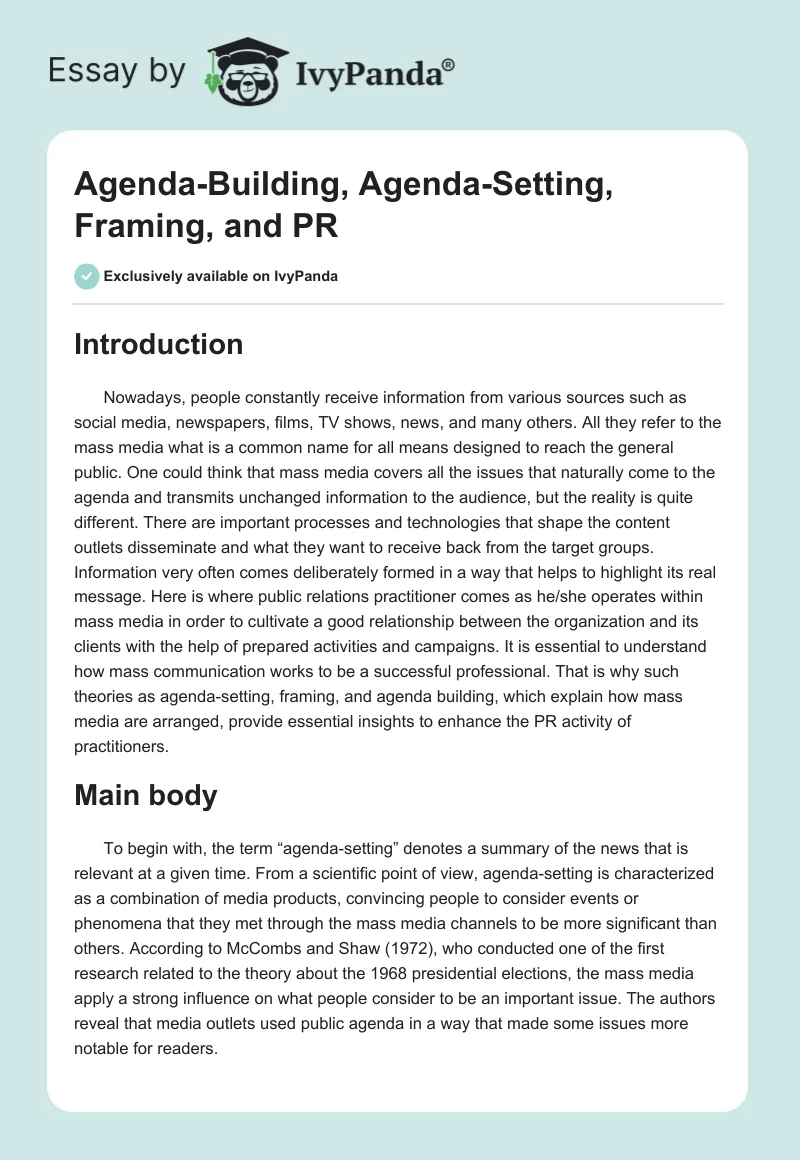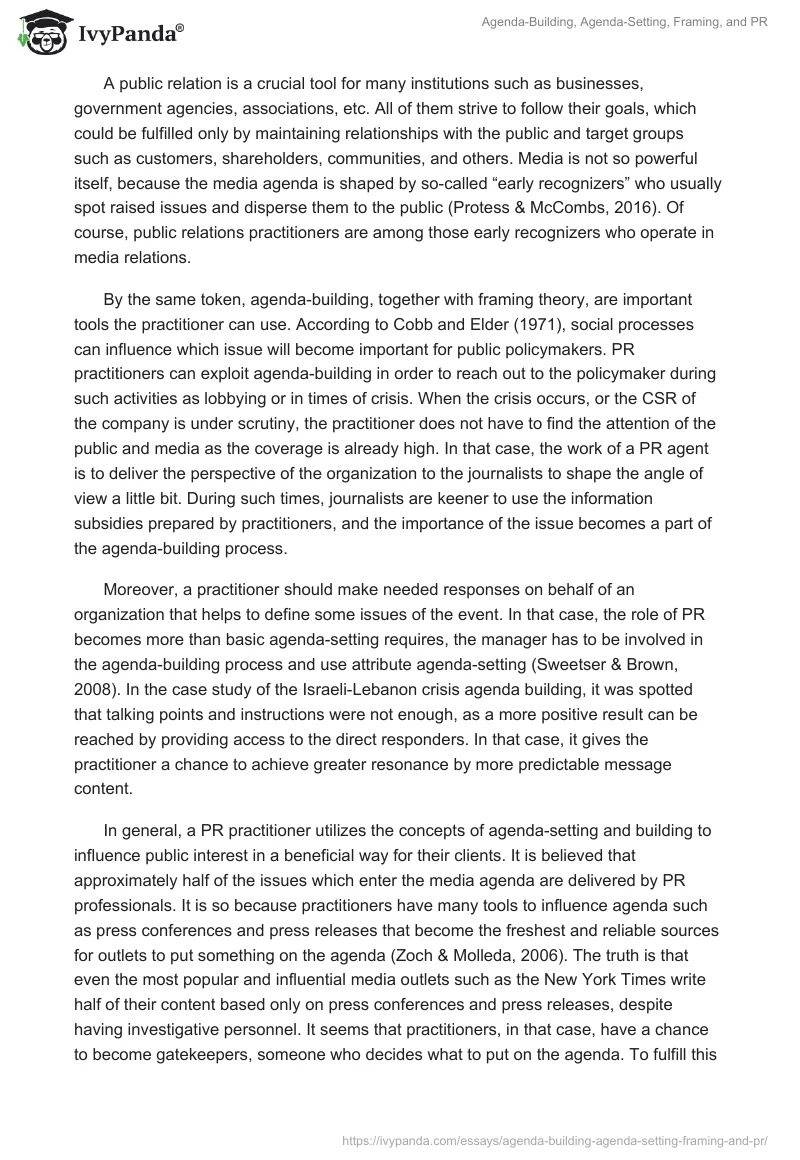Introduction
Nowadays, people constantly receive information from various sources such as social media, newspapers, films, TV shows, news, and many others. All they refer to the mass media what is a common name for all means designed to reach the general public. One could think that mass media covers all the issues that naturally come to the agenda and transmits unchanged information to the audience, but the reality is quite different.
There are important processes and technologies that shape the content outlets disseminate and what they want to receive back from the target groups. Information very often comes deliberately formed in a way that helps to highlight its real message. Here is where a public relations practitioner comes as he/she operates within mass media in order to cultivate a good relationship between the organization and its clients with the help of prepared activities and campaigns.
It is essential to understand how mass communication works to be a successful professional. That is why such theories as agenda-setting, framing, and agenda building, which explain how mass media are arranged, provide essential insights to enhance the PR activity of practitioners.
Main Body
To begin with, the term “agenda-setting” denotes a summary of the news that is relevant at a given time. From a scientific point of view, agenda-setting is characterized as a combination of media products, convincing people to consider events or phenomena that they met through the mass media channels to be more significant than others. According to McCombs and Shaw (1972), who conducted one of the first research related to the theory about the 1968 presidential elections, the mass media apply a strong influence on what people consider to be an important issue. The authors reveal that media outlets used public agenda in a way that made some issues more notable for readers.
A public relation is a crucial tool for many institutions such as businesses, government agencies, associations, etc. All of them strive to follow their goals, which could be fulfilled only by maintaining relationships with the public and target groups such as customers, shareholders, communities, and others. Media is not so powerful itself, because the media agenda is shaped by so-called “early recognizers” who usually spot raised issues and disperse them to the public (Protess & McCombs, 2016). Of course, public relations practitioners are among those early recognizers who operate in media relations.
By the same token, agenda-building, together with framing theory, are important tools the practitioner can use. According to Cobb and Elder (1971), social processes can influence which issue will become important for public policymakers. PR practitioners can exploit agenda-building in order to reach out to the policymaker during such activities as lobbying or in times of crisis. When the crisis occurs, or the CSR of the company is under scrutiny, the practitioner does not have to find the attention of the public and media as the coverage is already high. In that case, the work of a PR agent is to deliver the perspective of the organization to the journalists to shape the angle of view a little bit. During such times, journalists are keener to use the information subsidies prepared by practitioners, and the importance of the issue becomes a part of the agenda-building process.
Moreover, a practitioner should make needed responses on behalf of an organization that helps to define some issues of the event. In that case, the role of PR becomes more than basic agenda-setting requires, the manager has to be involved in the agenda-building process and use attribute agenda-setting (Sweetser & Brown, 2008). In the case study of the Israeli-Lebanon crisis agenda building, it was spotted that talking points and instructions were not enough, as a more positive result can be reached by providing access to the direct responders. In that case, it gives the practitioner a chance to achieve greater resonance by more predictable message content.
In general, a PR practitioner utilizes the concepts of agenda-setting and building to influence public interest in a beneficial way for their clients. It is believed that approximately half of the issues which enter the media agenda are delivered by PR professionals. It is so because practitioners have many tools to influence agenda such as press conferences and press releases that become the freshest and reliable sources for outlets to put something on the agenda (Zoch & Molleda, 2006). The truth is that even the most popular and influential media outlets such as the New York Times write half of their content based only on press conferences and press releases, despite having investigative personnel. It seems that practitioners, in that case, have a chance to become gatekeepers, someone who decides what to put on the agenda. To fulfill this chance PR professional has to maintain warm relations with journalists and editors, while they are usually interested to cooperate with a purpose to receive needed information. Such ties give a possibility for practitioners to propel their organizations on the agenda when it is needed.
Agenda-setting and building theories have been discussed earlier, so it is time to break down framing theory. This concept is connected with agenda-setting but focuses more on the meaning of the issue than on a specific theme. The main difference between the theories is that framing deals with second-level agenda-setting what means that frames help to shape how the public thinks about the particular issue. Basically, frames are abstract concepts that serve to organize or structure social meanings. It means that framing can persuade the reader to join a particular side of the issue and determine how people process the information. People look at the information through their own frameworks what are natural and social ones. Those frames define how public process, interpret and communicate the received information.
Furthermore, framing in the hands of PR professionals plays four important functions in delivering the client’s message to the public (Zoch & Molleda, 2006). They identify triggers of the issue which can be found both in and out the organization, evaluate the situation which causes the issue from the moral point of view, define the problems themselves, and provide the ways how these problems can be treated. The famous Nike case at the end of the 1990s concerning human rights issues breaches proved that with the help of counter framing, it is possible to win over customers, investors, and media actors even being in a drastic situation. PR practitioners of Nike turned around the problem of work abuse in the way that the company always cared more than others about Asian workers and was falsely accused. As a result, many giant outlets reported that Nike is setting standards for contract labor and improving HR agenda (Waller & Conaway, 2011). This case can be helpful for PR professionals dealing with CSR and sustainability issues in terms of understanding and learning from communication strategies used in Nike’s framing effort.
Conclusion
To conclude, all the theories mentioned above should be comprehended by public relations practitioners regardless of their clients or field of operation. Agenda-setting gives an insight into how media decides what to add to the agenda, what defines which piece of information will be shared with publicity. In its turn, agenda-building is the process that complements agenda-setting and points at tools of cooperation practitioners have at their disposal to “insert” the organization into the media agenda. And the theory of framing tells how media present issues to change the way how the audience perceives the issues.
References
Cobb, R. W., & Elder, C. D. (1971). The politics of agenda-building: An alternative perspective for modern democratic theory. The Journal of Politics, 33(4), 892-915.
McCombs, M. E., & Shaw, D. L. (1972). The agenda-setting function of mass media. Public Opinion Quarterly, 36(2), 176-187.
Protess, D., & McCombs, M. E. (2016). Agenda Setting: Readings on media, public opinion, and policymaking. New York: Routledge.
Sweetser, K. D., & Brown, C. W. (2008). Information subsidies and agenda-building during the Israel–Lebanon crisis. Public Relations Review, 34(4), 359-366.
Waller, R. L., & Conaway, R. N. (2011). Framing and counter framing the issue of corporate social responsibility: The communication strategies of Nikebiz. com. The Journal of Business Communication (1973), 48(1), 83-106.
Zoch, L. M., & Molleda, J. C. (2006). Building a theoretical model of media relations using framing, information subsidies, and agenda-building. Public relations theory II, 279-309.


